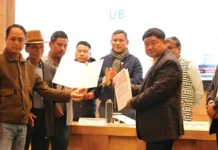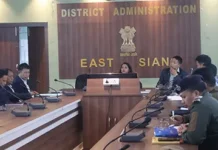[ Maj Gen SC Mohanty ]
Consequent to the sectoral disengagement (not de-escalation) at Pangong Pso, the PLA has largely stonewalled any further negotiations with respect to reversion to the pre-April 2020 status in other friction points along the line of actual control (LAC) with India. To the contrary, there are reports of further consolidation all along the LAC in the TAR in terms of heliports, air defence locations, missile emplacements, surveillance resources and construction of modern border villages, besides feverish infrastructure development. The recent completion of road connectivity between Nyingchi and Baidung in Medog county, reducing the travelling time by eight hours (from 346 kms to 180 kms) and mobilization opposite the Tuting sector and upgrading of a village on the bank of the Tsari Chu river, in occupation by China since 1959, opposite Upper Subansiri district of Arunachal Pradesh, only renders further credence to possible flashpoints along the Arunachal Pradesh LAC. The statement of a spokesman of the western theatre command of the PLA that “India side should cherish the current positive trend (apparently indicating no further disengagement)” only underscores the ominous signs of Chinese territorial belligerence along the disputed borders.
Infrastructure development on the Indian side has also picked up pace, though nowhere in comparison with China. With rebalancing towards the northern borders in terms of troops deployment and combat resources, India may be able to build up a dissuasive deterrence posture against the emerging threat in the immediate future, at least in contact warfare. However, the practice and asymmetry in the grey zone and non-contact warfare, including cyber, EW, informatization, psychological and other domains demand that India cannot confine itself to only the military domain to stymie the Chinese territorial ambitions. Other components of the comprehensive national power (diplomacy, economic and information) would have to also play a significant role.
The prevailing and foreseeable geopolitical and geo-strategic environment constitutes strong head winds for China’s global ambitions in multiple domains. It has been facing unprecedented accusations, including the Covid-19 obfuscation, credible and inviolable evidence of human rights violations in Xinjiang, military belligerence in the maritime territorial assertions against the Philippines, Taiwan (violation of AD 12), Vietnam and Indonesia. There have been subdued but discernible territorial aggressions in northern Bhutan and even Nepal. The recent violation of the Malaysian airspace has only made matters worse between the hitherto not-so-unfriendly countries. The recent disconnect between the Chinese and the ASEAN approach towards internal turmoil in Myanmar does not make an encouraging environment for the Chinese in its immediate neighbourhood. In an unprecedented move, Xi Jinping appears to have pressed the pause button on the much publicized wolf warrior diplomacy (reaching its zenith at Anchorage in Alaska) to hold and tone down aggression and display modesty and humility, apparently to make China’s standpoint more acceptable to the international community.
In the prevailing environment, the Sino-India relationship seems to have reached an inflection point and a case for India to undertake a reappraisal of its restrained and appeasement strategy vis-à-vis relations with China to one of greater assertiveness and conviction in domains other than pure military, to take advantage of numerous socio-cultural and political fault lines of the Chinese. Despite severe provocations, including losing lives in eastern Ladakh, India has not so far jumped into the western bandwagon to directly accuse China in either Covid-19 complicity, national security law in Hong Kong, human rights violations in Xinjiang, or for that matter in the South China sea (despite setback in oil exploration off the Vietnamese coast). India continues to consider the Quad as an informal alliance for regional cooperation and is emphasizing on a free and open Indo-Pacific rather than an overt anti-China military alliance. In the evolving contemporary context, there is a case for India to evaluate its Tibet policy, especially in light of its vulnerability along the LAC and the importance of a democratically governed and friendly Tibetan autonomous region along the northern borders.
China invaded/annexed Tibet in 1950-51 as part of its effort to integrate Tibet as part of its territory, which resulted in destruction of thousands of monasteries, killing of Tibetan Buddhists and cultural genocide of a peaceful Tibet. The 17 Point Agreement was signed by the Tibetan delegation (not authorized by Lhasa) under duress by Chinese delegation due to hugely superior military forces in Tibet. Over the last 70 years, there has been a systematic effort to Sinicize Tibetan Buddhism with Chinese characteristics. Control over functioning of monasteries is being maintained by management committees controlled by local officials and party cadres, documentation of all disciples and listing out what each monastery must have (nine haves – including photographs of communist party leaders) and structured mechanism to prevent what Chinese call as separatist agenda/allegiance to the Dalai Lama. Focused approach towards development of infrastructure in the TAR includes the Tibetan Work Forums, first established in 1980 (the seventh one being held in 2020) and the international conference on Buddha and Buddhism to pursue what the Chinese Communist Party constitutes the Chinese rejuvenation. The demographic inversion of the TAR with large influx of Han Chinese and subjugation of religious beliefs is all too evident. The visit of Chinese State Counsellor and Foreign Minister Wang Yi in July 2020 to Lhasa for the first time in decades, besides visiting the border areas, and Xi Jinping’s address during the seventh symposium on Tibet Work Forum, particularly emphasizing on secure and impregnable borders, besides numerous visits by both communist party functionaries and senior officials of the PLA only goes to prove the Chinese sensitivities/vulnerability in the region. However, despite decades of coercive policies, subjugation of religious beliefs, the peaceful integration of TAR, both political, religious and spiritual, along with development is far from having been achieved when seen against the backdrop of the 2008 uprising and over 150 self-immolations having taken place since 2009 for religious freedom. The thriving democratic functioning of the central Tibetan administration (in exile) in India with the latest elections held in April 2021 with a new President Penpa Tsering sworn in on 27 May, 2021, outreach to Chinese government for a mutually beneficial non-violent solution only indicates its undiluted aspiration for a free Tibet, and cultural, spiritual and democratic urge of the Tibetan Buddhist population. The recent visit of the erstwhile president of the CTA to the White House gives further credence to its legitimacy by the West.
India has seldom exploited its credible ‘Tibet card’ with the Dalai Lama and over one lakh Tibetan refugees in India to trigger dissention both inside Tibet and among the Tibetan population in exile in other countries. This is despite intense provocation by the Chinese, including issuing of stapled visas to people from Arunachal Pradesh (calling it South Tibet), unsuccessful attempts in convening a special session of the UN Security Council on revocation of Article 370 by India and reluctance in designation of Masood Azhar as a global terrorist.
In 2007, China’s state administrative religious affairs bureau issued its Decree No 5, ruling that reincarnation of all future living Buddhas are valid only once approved by the China’s central government (meaning the Communist Party), an order that runs counter to the Tibetan Buddhist belief that it is the prerogative of the Dalai Lama alone to decide on his reincarnation. This has been reiterated by the 14th Dalai Lama in multiple fora. The Chinese concept of use of the Golden Urn for selection of the Dalai Lama, ostensively adopted in the late 18th century, was only used to select the 11th Dalai Lama and does not enjoy wider acceptability. Even in the case of Panchen Lama, only the 8th and the 9th Panchen Lama were selected following the process of the Golden Urn, a concept enforced on the Tibetan Buddhists by the Manchus who provided military support to Tibetans against the Gurkhas in 1791/92.
It is imperative for India to step in to control the process of selection of the 15th Dalai Lama before events in the TAR overtake/preempt the actions of the Dalai Lama’s office/CTA. It may be pertinent to point out that the process of selection of the 15th Dalai Lama may have actually begun with the visit of Gyaincain Norbu, the Chinese Panchen Lama, to Lhatso lake in Lhasa in 2018 for worshipping, an activity that seeks to legitimize the process followed for the rebirth of the Dalai Lama.
It is in India’s interest to proactively facilitate the process of nomination of the 15th Dalai Lama while following the established and well-recognized spiritual practice of Tibetan Buddhism, especially in the backdrop of the Tibetan Policy and Support Act, 2020, passed by the US in December 2020 that seeks to sanction any Chinese authority that interferes in the process of reincarnation of the 15th Dalai Lama. While the 14th Dalai Lama at different times has expressed varying views with respect to selection of the Dalai Lama, including no further reincarnation, Dalai Lama from India/Mongolia, possibility of a woman Dalai Lama and a scenario of no Dalai Lama at all, a degree of clarity must emerge. Searching for a reincarnation post death of the current incumbent has multiple challenges, including concurrent process of reincarnation by the Dalai Lama’s office and China. In the past, there have been long periods of no Dalai Lama after the death of the previous Dalai Lama and the reincarnation, which at times is close to 20-25 years. During this period, regents take over the spiritual management of the followers, resulting in uncertainly, infighting and even sectarian violence. It would be most ideal for the Dalai Lama to follow the concept of emanation (superior bodhisattvas can manifest themselves in hundreds or thousands of bodies simultaneously) and commence of process of spiritual education of the next reincarnation as an established practice, so that there is no vacuum in spiritual leadership in Tibetan Buddhism. The four primary sects of Tibetan Buddhism, viz, Gelug, Sakya, Nyingma and Kagyu, have 80 percent convergence in their religious beliefs and precepts and unequivocally follow the Dalai Lama, who is the central figure of unity and bonhomie amongst the Buddhists. At the same time politico-diplomatic-religious coherence amongst the Buddhist population both in south Asia and other parts of the world is necessary, through diplomatic engagements to garner support for the Dalai Lama’s prerogative to choose his reincarnation. The international community must be sensitized against the perpetration of another Xinjiang in the making.
While the Dalai Lama has mentioned that the process of his successor will commence when he turns 90 years (in 2025, and he expects to live upto 113 years), prudence demands that India takes all possible measures to steer the process of reincarnation of the 15th Dalai Lama to retain firm control over the century old cultural, spiritual and religious affinity with the Tibetan population, besides retaining strategic leverage along the LAC. (The writer is security advisor, GoAP)



